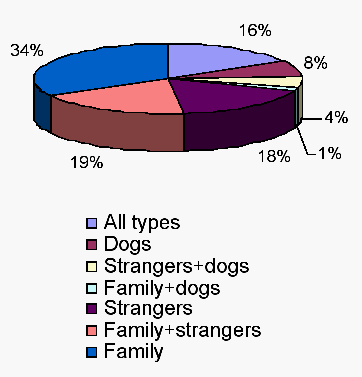
Statistics (Euthanasia of dogs) |
||
|
Statistical information on euthanasia of dogs with behavioural problems in Denmark A study of dog euthanasia conducted in Denmark in 1997-1998 showed that, of the 2,493 euthanased dogs surveyed, 23.6 % were euthanased in response to behavioural problems. In approximately two-thirds of these cases, the problematic behaviour was classified as aggressive (see Figures 1 and 2). Next to age-related factors, inappropriate behaviour is the most common reason for euthanasing dogs in Denmark. Of the dogs euthanased as a result of such behaviour, less than 16% had received any form of prior treatment. Where treatment was given, it most often (i.e. in 68.1% cases) involved obedience training, neutering, and/or medication with psychopharmacologic agents or progestines. Less than 4.9% of the dogs euthanased following behavioural problems had received other forms of treatment such as professional veterinary behavioural counselling and therapy. Behavioural problems |
||
 |
||
|
Figure 1 Distribution of reasons for euthanasia of dogs with behavioural problems Aggression problems |
||
 |
||
|
Figure 2 Distribution of the objects of aggression (Source: Mikkelsen, J. & J.D. Lund (1999): Euthanasia of dogs because of behavioural problems. An epidemiological study on euthanasia of dogs in Denmark – with particular reference to aggression problems. Dansk Veterinærtidsskrift 82: pp.474-479) Number of dogs euthanased in response to behavioural problems in Sweden A Swedish study, conducted in 1999-2000, surveyed 290 owners of dogs with behavioural problems. It was found that 29.7 % of the dogs had been euthanased. The study does not record the reasons for euthanasia, but the two main behavioural problems reported were aggression (51.4%) and anxiety (44.1%). (Source: Malm, K.(2001): Problembeteende hos hundar – en inventering. Forskningsrapport. Djursjukhuset i Skara, SLU, Sweden) |
||